Today is the official release day for OVER AND UNDER THE SNOW, my Chronicle picture book illustrated by the amazing Christopher Silas Neal. It tells the story of a girl who goes cross country skiing with her father and discovers the secret world of animals living under the snow.
This Sunday, I’ll be signing books at a really special event — a gala fundraiser at The Bookstore Plus in Lake Placid, to help the nearby Wells Memorial Library recover from flooding during Tropical Storm Irene. In addition to the silent auction and other benefit events, 20% of sales from the evening will be donated to the library. If you’re planning to purchase OVER AND UNDER THE SNOW and would like a signed copy, please consider ordering through The Bookstore Plus. You can give them a call at 518-523-2950 any time between now and Saturday. Just let them know how you’d like it signed and that you’d like it to count toward the library fundraiser. I’ll sign your book Saturday evening, and they’ll ship it out next week.
To celebrate the big release today, I invited illustrator Christopher Silas Neal to visit my blog and talk a little about his process for this book, from start to finish.
Hi, Chris! Let’s start at the very beginning… When a potential project like this one first crosses your desk at an illustrator, what are the things you consider when you’re deciding whether to take it on and then how to approach it?
I knew right away, this was the story for me. It’s simple, filled with great animal imagery and has a classic sensibility. It’s a quiet story which I thought would pair well with my visual approach which is most often simple, muted and restrained. Under the Snow isn’t a character driven narrative in the way most children’s books are. In this case, nature is the true star of the show and for my first endeavor into picture book making, I was looking for something that was more about atmosphere and less about designing and creating a character. The fact that your story takes place in the winter makes it all the better. Just a few words into your manuscript and I had already envisioned how white space and trees could be used to frame each page and how the layers of snow would frame each animal drawing. It’s a good sign when I can begin to envision the art before I’ve finish reading. I had a gut feeling I would enjoy making art for this book.
Could you decide what your process was like for OVER AND UNDER THE SNOW (i.e. section of medium, research, planning, sketching, etc…all the way to finished art)?
You’ve managed to write something emotional, magical- with a great sense of rhythm that’s also jammed packed with information. The biggest challenge illustrating this book was maintaining a healthy balance of poetic-ness with educational and factual imagery. These two goals are seemingly at odds and an extremely subjective goal at the very least. I spend a great deal of effort eliminating reality from my work be it with loss of visual perspective and gravity, using abstract colors or, by simply letting emotion rather than logic guide me. With this book, it was necessary to add some of that reality back into the pictures. Ultimately, that tension between imaginary and fact is what makes this book unique and more unexpected than had the imagery been 100% scientific or 100% ethereal. Much like your beautiful words in Under and Over the Snow, the art is completely true yet is filtered through the imagination of a child.
This balance wasn’t achieved easily and It took a few rounds and some coaxing from Art Director Amelia Mack and Editor Melissa Manlove at Chronicle Books before we found the right mix. We started with a test piece which feels quite different from the art in the final book. The animals are blue and red- very cute and characters all to themselves. The problem with this approach is that they lack mystery and intrigue. They feel more like friends than they do an elusive ecosystem of creatures darting in and out of trees and freshly packed snow. With big eyes, and friendly smiles, we might expect the beaver, chipmunk or bear to strike up a conversation.
We did another round, this time adding more variety in color and eliminating some of the smiley faces. There’s still room for abstraction and imagination but in this next piece, I think we found the right mood and treatment for the animals.
At this point it was time to do sketches. Sketching is an essential part of the art making process. Drawing is thinking, sketching is planning- putting pencil to paper is how an artist arrives at ideas. When sketching for this book I kept everything loose and concerned myself more with the overall story and also how to break up the words on each page. Where should the next page begin? How big should the chipmunk be? What imagery will be on this page? How is the overall pacing of the book? Are there enough little animals and big animals, close ups and wide shots? These are the kinds of questions I would try to answer while drawing. Later on, I would work out how each creature would be drawn and what each tree will look like. My test piece was already approved by you, Amelia and Melissa- we had a good idea of what the final art would like so, it wasn’t as necessary for the sketches to reflect those kinds of details.
We tried a lot of different ideas including die cut pages (pages that are cut in irregular shapes) to reveal the animals under the snow. Dummies or miniature versions of the book, are a great way to study how the words and pictures are working as you flip through the pages. We would staple together my drawings into a little book and read through the story.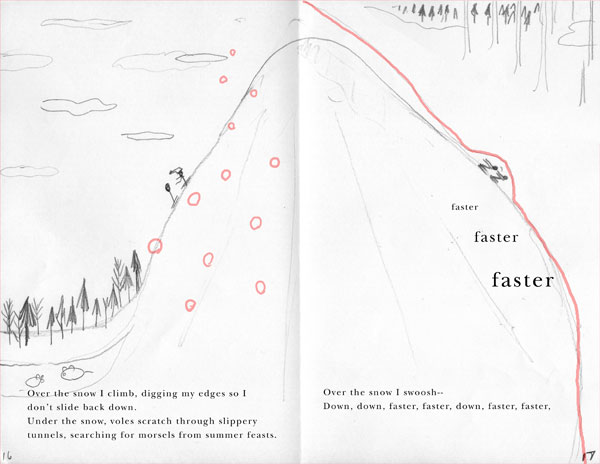
Next we solicited the help of an expert who examined my sketches and gave me pointers on how the animals would behave, their body position, and how each creature interacts with their environment. At this point I started looking for reference images. Some came from the expert, some I found researching books and on the internet and others came from you. I use reference in a lot of different ways. When drawing something very specific like a beaver’s lodge or a fox’s leap, a photo helps ensure that I know all the parts and proportions. Even if I distort or abstract these images in my drawing style, knowing how they look photographically helps. Other reference is purely for inspiration and I spent a lot of time looking at old naturalist drawings of animals and trees from the late 19th century.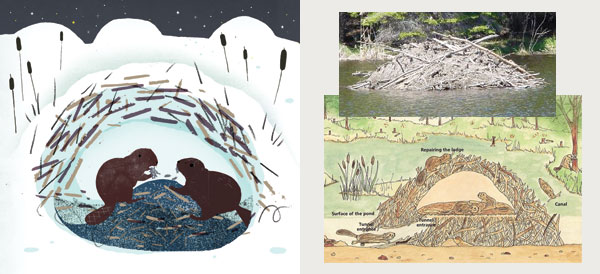
This would probably be a good time to talk about how I made the final images for the book. My process is a mix of drawing, painting, printing making and digital art. I always start with an under drawing. From there I imagine how I might break up the image and how each part of an image will be created. The body of a chipmunk might be created by using acrylic paint, a brayer and a stencil. His eyes, nose and stripes created with pencil. I create each part separately, scan them, and put the parts back together again on the computer while also adding color. This allows to me use various different media for one image and the flexibility to move things around until I get it just right.
The process of turning sketches into pictures is what we call in the business “final art.” But, it’s not really final at all. From here we make little adjustments sending artwork back and forth to the publisher and, to you, to make sure everything is just right. Then, the printer sends proofs so we can see the color and check for last minute mistakes. And, after all of that hard work- I cross my fingers and hope the book looks great and that everyone loves it!
I know that you do a lot of work with advertising, magazine illustration, music, posters, and book covers. How is working on a picture book different from the other projects you’ve done?
This process is a lot longer. There are so many more parts in a picture book. For a book cover or poster, I create one image that embodies the entire story. Or more accurately, I attempt to extract one important detail from a story. It could be an object, character, or just an emotion. With a picture book, it’s not about setting a mood or summarizing- the art is there through the entire story. I had to learn to pace myself and not try to fill each page with every detail. With a book, it’s ok for some pages to be empty and some pages to be busy. I still have much to learn about the process and hope to get better and better as I make more picture books.
One last question… Which spread from this book is your favorite, and why?
Great question! I love them all of course. I really enjoyed creating the winter forest. While the animals were often drawn in a direct and straight forward manner in order to convey a fact, it was in the trees that I took liberties, using expressive marks and vivid colors. One spread that stands out for me is the fox leaping at his dinner.
I really love how he fills the page with red fur and, it’s one of the more energetic moments of the book. However, I do feel sorry the mouse- I’m sure other readers will feel the same way. In the context of observing nature, life and death are less about tragedy and more about balance. I suppose on this spread, it’s the fox’s time to shine, the mouse will have his turn on another page.
Chris, thanks so much for taking the time to share your incredible process – and thanks (yes…I’m going to say it again) for the gift of this art.
For anyone interested in learning more about Chris’s process, he has a great post on his own blog about creating the cover art for MAY B., a recent middle grade novel.
And again – if you’d like a signed copy of OVER AND UNDER THE SNOW, just call The Bookstore Plus – 518-523-2950 – by Friday to order!





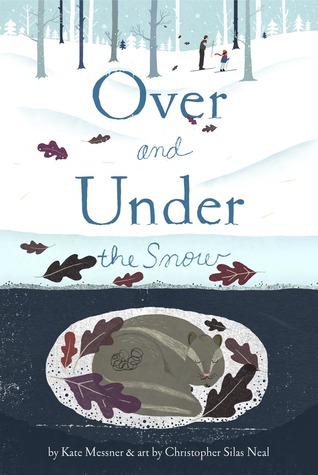
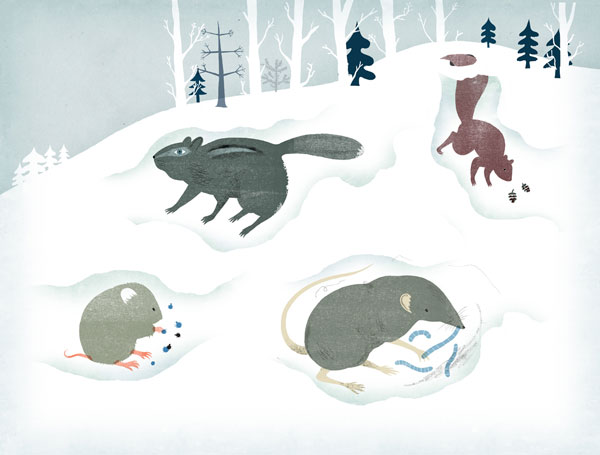
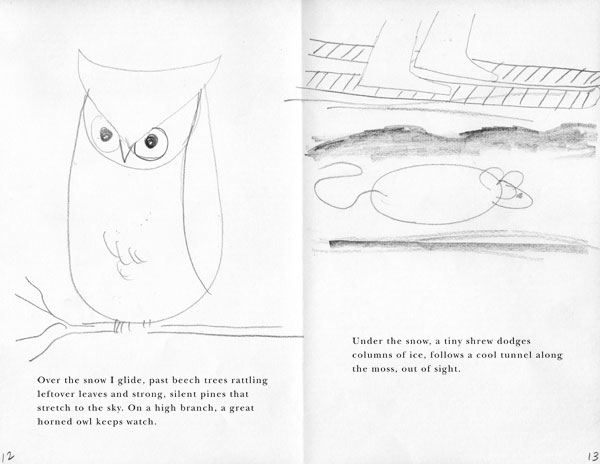
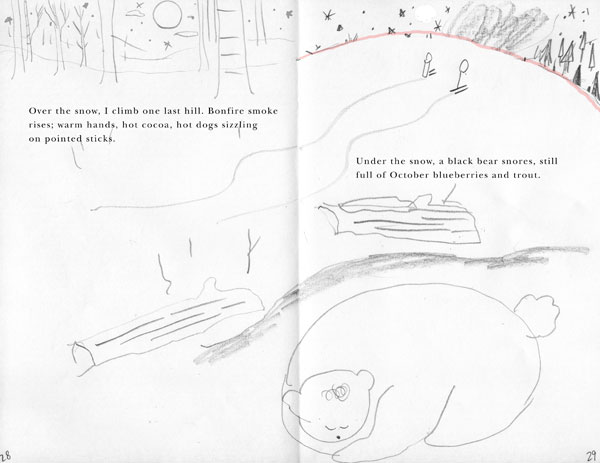
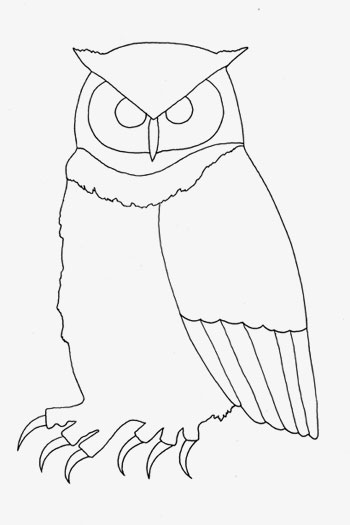
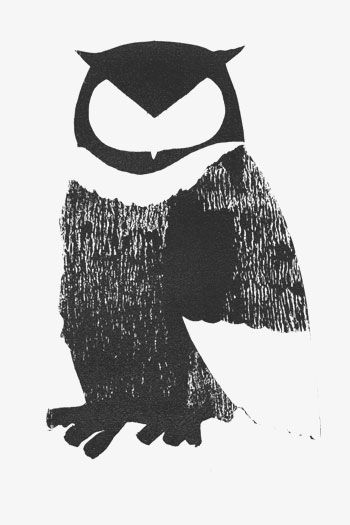

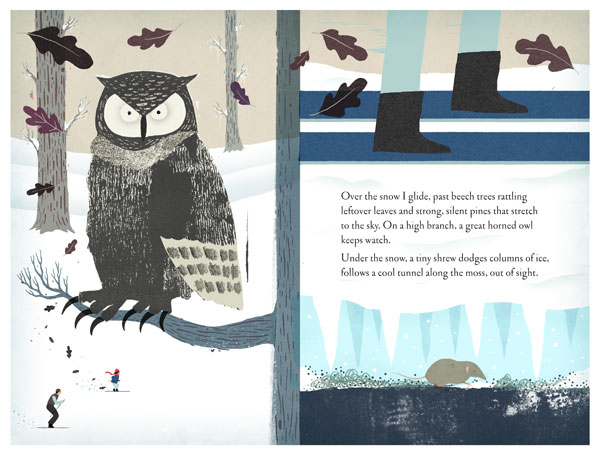

Bravo! What a treat to have this peak into the process within days of reading the book itself. Thank you, Kate and Chris. We Burnses are loving your book …
Loree
Hi there –
We just got your book in the shop & promptly sold out.
I’ve got another order in & they should be back in this week.
Funny thing… Your friends keep coming in because they see the book in the window.
And I just learned you live in our neighborhood.
We should do a book signing in the shop (Green in BKLYN @ http://www.greeninbklyn.com).
Interested?
PS – CONGRATULATIONS on an awesome book!
Thanks for the kind words about Over and Under the Snow (and for stocking it!) I think the folks coming in must be friends of illustrator Chris Silas Neal, who does indeed live in Brooklyn (I live way, way Upstate…on Lake Champlain). But I do get down to the city once in a while & will try to stop in on my next trip!